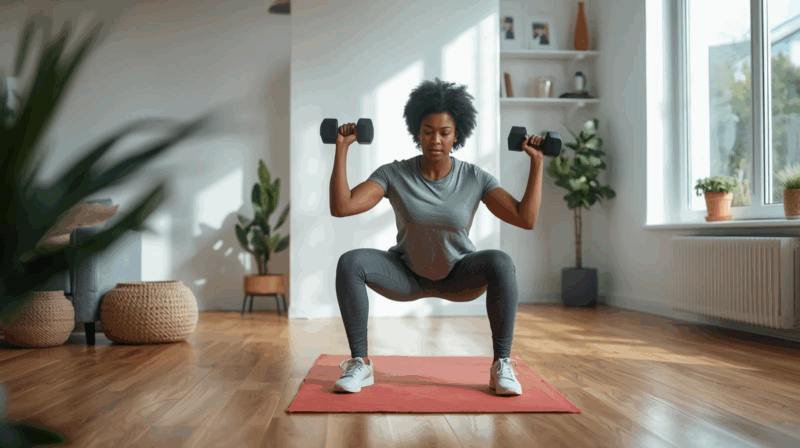How to Start Weight Training with Dumbbells (Free 7-Day Plan)
Why I Started Weight Training: A Beginner’s Dumbbell Guide for Strength, Health & Confidence
My Story: From Weight Loss to Strength Using Dumbbells

A few years ago, I was diving deep into food and health research, trying to understand how to feel better, have more energy, and age well. During that time, I stumbled across a video about using dumbbells from Dr. Gabrielle Lyon, who explained something I’d never really thought about: muscle isn’t just about looking fit, it’s actually a critical organ for health, especially as we get older.
Meanwhile, I had already lost quite a bit of weight. I felt proud of that achievement, but at the same time, I didn’t feel strong. I looked slimmer, yet deep down, I knew I wanted to look and feel healthier. In other words, the missing piece was muscle.
That realization led me to the next step. I started exploring strength training. At first, I bought a simple pair of dumbbells — nothing fancy — and tried a couple of short sessions a week. At the beginning, it wasn’t about bulking up; rather, it was about feeling capable in my own body.
Why Muscle Matters (Science in Plain English)
Here’s what I learned from experts like Dr. Gabrielle Lyon and Dr. Andy Galpin (highly recommend checking out their work,both share science-based, practical advice):
When most people think about building muscle, they imagine aesthetics looking leaner or more defined. But muscle is so much more than appearance; it’s one of the most powerful drivers of overall health.
First, there’s metabolism. Muscle tissue burns more calories at rest than fat, which means the more muscle you carry, the more energy your body uses each day, even when you’re not working out. It’s not a magic fix for weight loss, but it does give your daily calorie burn a subtle boost.
In addition, muscle plays a crucial role in blood sugar control. After you eat, your muscles act like a sponge, pulling glucose out of your bloodstream. This helps keep blood sugar levels stable and improves insulin sensitivity, key factors in long-term metabolic health.
What’s more, muscle is essential for healthy aging. As we get older, muscle helps protect against frailty, reduces the risk of falls, and supports independence. Dr. Gabrielle Lyon calls this “muscle-centric medicine,” and for good reason: without strong muscles, staying active and capable becomes much harder.
Beyond the health benefits, muscle changes how you move through the world. Everyday tasks, carrying shopping bags, climbing stairs, or playing with your kids, become easier and more enjoyable when your body is strong.
But there’s something else: improved balance and stability. Dumbbells force each side of your body to work independently, which means better coordination and a lower risk of those awkward stumbles or minor falls that become more common as we age.
That sense of physical capability often translates into confidence in other areas of life too. There’s something empowering about knowing your body can handle whatever the day throws at you.
Finally, there’s bone and joint health. Strength training stimulates bone density and provides stability around your joints, which means fewer aches and pains and a lower risk of injury.
In short, muscle isn’t just about how you look, it’s about how you live. From metabolism to mobility, building and maintaining strength is one of the most powerful investments you can make in your long-term health.
📖 References: Dr. Gabrielle Lyon | Dr. Andy Galpin on zoe
🎧 Suggested listen: Mind Pump episode on minimum effective training dose (search “Mind Pump minimum workout time”).
How Much Time Do You Really Need to train with Dumbbells?
Here’s the good news: you don’t need to spend hours in the gym every day. In fact, research shows that as little as two 30-minute sessions per week can deliver noticeable results for beginners. With just that small commitment, you can increase strength, improve muscle tone, and boost energy
I started small, just two sessions a week. Now, training has become a habit I enjoy (and yes, more than cardio, I hate jumping around!). These days I do around 4 hours per week spread across a few sessions. But you don’t need to do as much as me to benefit.
Getting Started: What Dumbbells You Actually Need
You don’t need a fancy gym setup. I started with just one pair of 4 kg dumbbells, and that was enough for the first few weeks. For beginners, I’d recommend starting with 2 – 4 kg dumbbells depending on your current fitness level. If you’re completely new to strength training, err on the lighter side, you can always progress up do not risk injury especially on those shoulders.
The beauty of dumbbells is that they don’t take up much space. You can easily store them in a corner of your living room and have everything you need for a full-body workout.
As you begin lifting, nutrition and recovery become just as important as the workouts themselves. Some beginners also ask about supplements. One of the most researched and effective options is creatine, which supports strength, recovery, and muscle growth. 👉 Read Homosapien Health full guide to creatine here.”
The #1 Mistake I See Beginners Make
The biggest mistake? Trying to progress too quickly. I get it when you start seeing results, you want more, faster. But jumping up in weight too soon is a recipe for injury or burnout. Trust me I injured my shoulder and it put me out of training for 8 weeks
Instead, focus on mastering the movement first. Once you can complete all your sets with good form and the weight feels genuinely easy, then it’s time to progress. Your future self will thank you for building a solid foundation.
My Dumbbells Training Now (and Why I Stick With It)
Do I enjoy weight training? Honestly, yes, most days. Not every session is Strength training might not come with fireworks, but compared to cardio, it’s far more enjoyable for me. And over time, the benefits have really stacked up.
For one thing, I feel stronger in daily life.
On top of that, I look healthier with the added muscle.
Even more importantly, I’m more confident because I know I’m doing something protective for my long-term health.
And the best part? It’s become a habit. Most days, I just get it done—it’s simply part of who I am now.
Form First: Three Dumbbells Key Safety Points
Before you start lifting, remember these fundamentals:
1. Control the weight, don’t let it control you. Lower the weight slowly and with control this is where a lot of the muscle-building magic happens.
2. Keep your core engaged. Think of your core as your body’s natural weight belt. A tight core protects your spine and improves your overall stability.
3. Start light and focus on feeling the movement. It’s better to use lighter weights with perfect form than heavy weights with sloppy technique. You’ll build strength faster and avoid injury.
What The Science Actually Says
Form First, Heavy Weights Later
The fitness world loves to debate heavy weights versus light weights, but research consistently shows something more nuanced: proper technique is essential for beginners, regardless of weight choice.
Recent studies have found that both the light weight and heavy weight groups gained equivalent muscle mass when volume was equated for, and middle-aged men and women who started lifting light weights gained about the same amount of strength and mass as others who used much heavier weights.
Exercise scientists recommend beginners start with just 2-3 workout days per week. Their research shows you can build strength and muscle by doing each exercise 8-12 times in a row (called ‘reps’), taking a short break, then repeating that 1-3 times (called ‘sets’). But here’s what they don’t emphasize enough: before worrying about how many times to lift something, you need to learn how to lift it safely first.
What Works for You Matters More Than What Works for Everyone Else
The latest ACSM guidelines acknowledge something crucial: evidence-based standards with several new sections, including updates on sex differences show that individual factors your age, gender, injury history, and goals, matter far more than following a one-size-fits-all approach.
This is why starting light, focusing on form, and gradually finding what works for your body isn’t just safer, it’s actually more effective in the long run.
Beginner’s 7‑Day Dumbbell Plan (Free eBook)
I’ve put together a printable 7‑day beginner dumbbell plan with exercise cues, habit trackers, and progression tips. It’s designed for absolute beginners, using only light or moderate weights.
Get the Free 7-Day Dumbbell Plan
Enter your email to download your printable beginner workout plan instantly.
What Weight Training Does for Your Body (Quick List)
- Boosts metabolism (burn more calories at rest)
- Improves insulin sensitivity (better blood sugar control)
- Strengthens bones & joints (lower risk of osteoporosis)
- Supports posture & mobility
- Enhances mental health (proven stress reliever)
- Builds resilience (both physical and mental)
- Improves balance & stability (dumbbells force each side of your body to work independently)
Final Thoughts
If you’re just starting out, don’t overcomplicate it. A couple of dumbbells, 20–30 minutes twice a week, and a focus on good form are enough to get real results.
**And if you’re like me—**someone who lost weight and wanted to feel healthier, not just lighter, building muscle might be the missing piece you’ve been looking for.
The truth is, you don’t need to train like an athlete. Instead, start small, stay consistent, and let strength gradually change your life.
So, are you ready to try? Grab those dumbbells, set aside 20 minutes this week, and try Day 1 of my beginner plan. You’ll be surprised how quickly strength builds when you just get started.
Download my free Get Started with Dumbbells eBook and follow the 7-day plan. In just a few weeks, you’ll build confidence & feel stronger.
The Perfect Plan Mindset
The Best Plan Is the One you Will Actually Do !
Here’s the truth: unless you’re training to be a bodybuilder, your workout doesn’t need to be perfect—it just needs to happen.
Looking back, I spent way too much time in the beginning researching the “optimal” routine, the “best” exercises, the “perfect” rep ranges. Instead, what I should have been doing was just starting and figuring out what I actually enjoyed.
The reality is that everyone’s different. Some people love full-body workouts, while others prefer splitting up muscle groups. Similarly, some thrive with 20-minute sessions, whereas others need 45 minutes to feel satisfied. On top of that, some days you’ll feel strong, other days you won’t—and that’s completely normal.
Ultimately, the magic isn’t in finding the perfect program; it’s in finding something you can stick with long enough for it to become a habit. So try different approaches, pay attention to what feels good, and don’t be afraid to adjust as you go.
Remember: your body will respond to consistency far more than it will to perfection. Therefore, start somewhere, anywhere, and let your preferences develop along the way.
Please, please just start.
However, I need to be honest with you: this isn’t going to be easy at first. You’re not just learning new exercises—you’re building a completely new identity. In other words, you’re becoming someone who resistance trains. That’s a bigger shift than it sounds.
Initially, motivation will get you through the first few sessions, maybe even the first few weeks. But here’s the thing—motivation is fickle. It disappears on busy days, stressful weeks, or when you just don’t feel like it. What you’re really building is a habit, and habits take time to stick.
Inevitably, there will be days when you don’t want to pick up those dumbbells. Do it anyway—even if it’s just for 10 minutes. Likewise, there will be weeks when you feel like you’re not making progress. Keep going anyway. Because ultimately, the magic happens in the showing up, especially when you don’t feel like it.
(I dive much deeper into the habit-building process and give you specific strategies in my free eBook—because knowing how to make this stick is just as important as knowing how to lift.)
Kel is the writer behind Everyday Mastery, where she shares the real, messy, and meaningful process of building habits, resilience, and self-belief from the ground up. Her writing blends ancient philosophy with modern science, always focused on small, practical steps that lead to lasting





